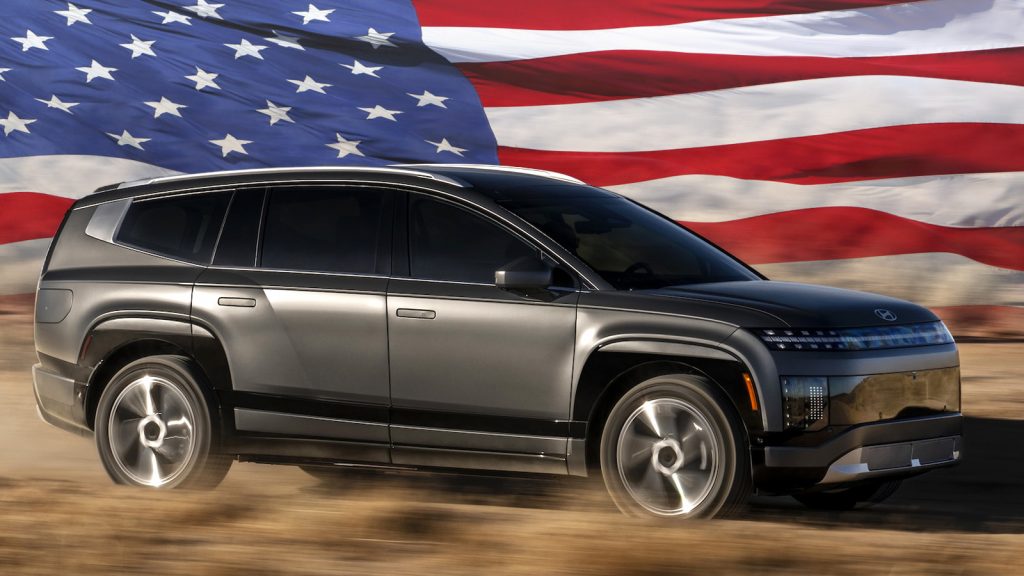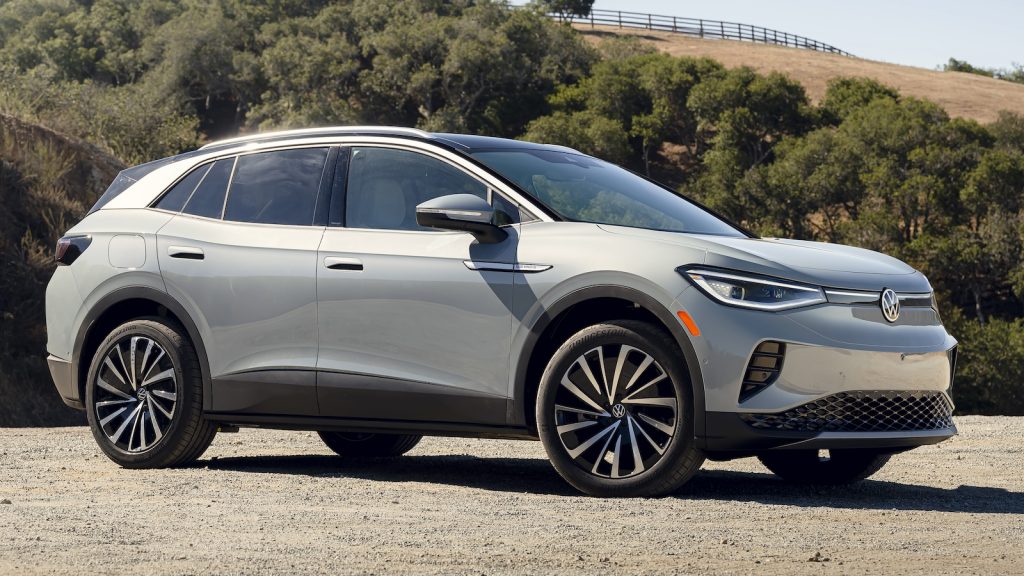Humans are strange, sometimes unpredictable beings. Other times, they are extremely easy to figure out. There’s been a sense that a lot of potential electric car buyers have been sitting on the sidelines, either holding onto a current electric car or waiting to try one out for the first time. Now, it’s like Cortland Finnegan is in the game, because the sidelines are emptying.
Obviously, this has to do with the expiration of the tax credit. Looking at those who have released numbers, it seems like buyers are getting into the market while there’s still inventory to buy. We’ll look at Hyundai and Kia first, as they both had record months. Ford and GM, as well, are doing super well.
![]()
Volkswagen? We won’t know for a while, but the company doesn’t expect this sugar high to last, as VW is slowing ID.4 production. What happens to dealers who are suddenly getting overwhelmed with EV purchases? The IRS is letting people file after September 30th, so long as a contract is signed.
Hyundai And Kia Both Have Record Months

It’s going to take a few days, or maybe a couple of weeks, to know for sure if American buyers hit a record for EV purchases (by share) in August, but my guess is seeming to hold true. The overall market is expected to increase by somewhere between 1-4% according to analysts, but EV sales are way up at Hyundai and Kia.
Hyundai saw total sales increase by 12%, and retail sales improved by 8% over last year, making the 88,532 units sold an all-time record for the brand. Electric cars? Up 72% year-over-year! On a monthly basis, the Ioniq 5 (+61%), Ioniq 6 (+30%), and new Ioniq 9 all crushed.
Kia also saw a big increase, with sales up 10.4% year-over-year for a record month. The EV9 was up 39% and the Niro EV improved by 57%. Curiously, the EV6 was down a little year-over-year. I can’t break out Niro sales, but my guess is that EV sales were up. (The company also sold a bunch of K5s, Carnivals, and even Souls).
GM And Ford Also Moved A Bunch Of Electric Cars

Ford’s sales numbers are hot off the presses, and the company did what I’m going to assume is about average for the market in August, seeing sales up by about 3.9% year-over-year. Not bad.
For the first time in a long time, though, electric car sales (+19.3%) outpaced hybrid car sales (+14.5%). That’s a reversal of the YTD trend. IRA Fever has hit Ford, and the company is now moving the Mach-Es it built (+35.3%), Lightnings (+21.2%), and… ok, the E-Transit sales aren’t great (down 76%). Ford doesn’t sell a ton of E-Transits, so the downturn there doesn’t sink the whole thing.
General Motors doesn’t break down monthly sales… unless it decides it wants to. It decided it wanted to this month, because GM was likely the 2nd biggest electric automaker in the United States again, thanks to being able to spread those cars around a bunch of brands. What the company said is that it sold more than 21,000 electric cars.
Obviously, this is because of the IRA tax credit expiring on September 30th. But what happens after that?
August was our best month ever for EV sales – and we expect that buying surge to pay long-term dividends, given our industry-leading manufacturer loyalty, and EV customers’ overwhelming commitment to the technology. I’m grateful to our team and our dealers for helping us outperform nearly every EV competitor.
We’re expecting strong demand once again in September. The question, of course, is what’s next? There’s no doubt we’ll see lower EV sales next quarter after tax credits end September 30, and it may take several months for the market to normalize. We will almost certainly see a smaller EV market for a while, and we won’t overproduce. Still, we believe GM can continue to grow EV market share.
Our confidence in the future of our EV business starts with our portfolio. Before there was an IRA, the strongest segments were affordable EVs and luxury, and we have those bases covered with our stunning Cadillacs, the Chevrolet Equinox EV, and soon, the new Chevrolet Bolt. And the style, performance, and industry-leading range of our Chevrolet, GMC and GMC HUMMER pickups and SUVs is unmatched.
Meanwhile, we are seeing marginal competitors dramatically scale back their products and plans, which should end much of the overproduction and irrational discounts we’ve seen in the marketplace.
I think that last sentence is an apt, if not a little pointed, view of the current environment. There are too many expensive, mediocre electric cars, and clearing them out of dealerships should help more established players.
VW Is Scaling Back ID.4 Production

Oh, yeah, speaking of: Volkswagen is going to slow its ID.4 EV crossover production as, frankly, people don’t see it as a competitive or compelling car.
As a result of the slowdown, 160 employees will be furloughed starting in late October. VW said it will supplement unemployment from the state of Tennessee, meaning affected workers will receive 80 percent of base compensation and continue to receive full benefits.
The slowdown began Sept. 2.
“This adjustment in no way changes our commitment to the ID4, our growing EV portfolio or our commitment to our Chattanooga team,” a VW spokesperson said in a statement. ”This is a market-driven decision, based on aligning our production volume to market demand.”
I’m guessing the VW got a little boost this quarter, but that’ll certainly fade once the tax credit fades.
Buyers Get A Paperwork Extension From The IRS

I think the increase in sales goes to show that there’s more pent-up demand for EVs than initially thought (We don’t know how many first-time EV buyers, but I bet plenty are. I think “everyone who wants an EV has already bought one” is far from true), and that maybe the issue with EV adoption is more rooted in the fact that most companies targeted the high-end of the Model Y pricing instead of something more affordable.
It also makes the cancellation of the tax credit a bit of a bummer. Is this the most efficient way to create a greener, healthier environment with government money? Probably not, but it’s better than nothing.
If you were planning to buy an electric car but are worried about getting your paperwork in before the September 30th deadline, the good news is that you’ll have a little more time, according to the IRS, in this Automotive News article:
The information from the IRS clarifies a point of confusion for the auto industry, since the credit originally applied to vehicles “placed in service.” That implied delivery of the vehicle was required before Sept. 30 for buyers to claim the $7,500 credit for new vehicles and $4,000 credit for used vehicles.
Now, delivery can take place after Sept. 30 and the buyer can still claim the credit.
“If a taxpayer acquires a vehicle by having a written binding contract in place and a payment made on or before September 30, 2025, then the taxpayer will be entitled to claim the credit when they place the vehicle in service (namely, when they take possession of the vehicle), even if the vehicle is placed in service after September 30, 2025,” the IRS said in its Aug. 21. guidance.
That’s something.
What I’m Listening To While Writing TMD
There’s a new Sabrina Carpenter album out, and I’m enjoying it. Specifically, I appreciate that her reference set is a lot more Dolly Parton than, say, Britney Spears or Whitney Houston. It’s a fun place for a pop star to be, and it suits her voice and personality quite well. The video for “Tears” is a deep homage to The Rocky Horror Picture Show, with the great Colman Domingo doing the Tim Curry role and Sabrina picking up the Susan Sarandon part. It’s fun!
The Big Question
Who is GM talking about here? Who are the marginal competitors in the EV space? Name names!
Top photo: Kia
Source link


